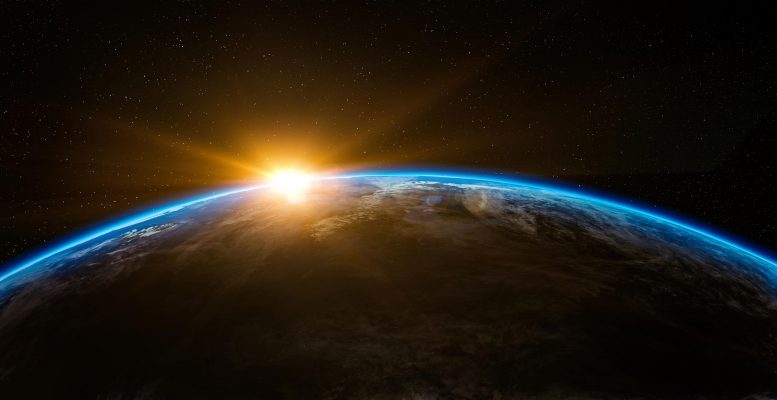
Oxygen became significantly present in the Earth’s atmosphere approximately 2.43 billion years ago, marking the onset of the Great Oxidation Event, a crucial period in the planet’s history.
The permanent rise of oxygen in the Earth’s atmosphere, which fundamentally changed the subsequent nature of Earth’s habitability, occurred much later than thought, according to new research.
And the study, from an international team led by the University of Leeds and including researchers from the University of California-Riverside, Harvard University, the University of Southern Denmark, and the University of St Andrews, also provides an explanation for some of the most extreme climate episodes to have affected the Earth, when the planet was repeatedly covered with ice.
“Now at last we have that piece of the puzzle.” — Professor Simon Poulton, Chair in Biogeochemistry and Earth History
The first time oxygen was significantly present in the atmosphere was about 2.43 billion years ago, and this marks the start of the Great Oxidation Event — a pivotal period in Earth’s history.
Although the Great Oxidation Event led to oxygen levels that were still much lower than today, it dramatically changed the chemical composition of the planet’s surface and set the stage for the subsequent course of biological evolution on Earth, which ultimately led to a planet teeming with animal life.
By analyzing rocks from South Africa, which were deposited in the ocean at the time of the Great Oxidation Event, the researchers discovered that early atmospheric oxygenation was short-lived, and oxygen did not become a permanent feature of the atmosphere until much later.
Professor Simon Poulton, of Leeds’ School of Earth and Environment, led the research.
He said: “The Great Oxidation Event fundamentally changed Earth’s environment and habitability. This early period of oxygenation was thought to have occurred between about 2.43 and 2.32 billion years ago.
“However, our research shows that, in fact, oxygenation of the atmosphere was highly unstable over a period of about 200 million years, with permanent atmospheric oxygenation occurring about 100 million years later than previously thought.”
Their findings, published in the journal Nature, also suggest a direct link between fluctuations in atmospheric oxygen concentration and greenhouse gas concentrations.
Professor Andrey Bekker of the University of California-Riverside, who co-authored the study, said: “These findings help explain four widespread glaciations that occurred coincident with the Great Oxidation Event, some of which were likely to have covered the whole of the Earth in ice for millions of years.
“Our new data show that the permanent rise of oxygen actually occurred after the final major glaciation of the period and not before it, which had previously been a major puzzle in our understanding of links between early atmospheric oxygenation and intense climatic instability.”
The research team has re-labeled this period the Great Oxidation Episode. It ushered in a 1.5-billion-year period of subsequent climatic and environmental stability, which remained until a second major period of rising oxygen and climate instability at the end of the Precambrian period.
Professor David Johnston, a co-author from Harvard University said: “The rise of atmospheric oxygen was a key factor in Earth’s habitability.
“Unravelling the history of atmospheric oxygenation ultimately allows us to understand how oxygen rose to levels that were sufficient to allow the evolution of animals.
“The Great Oxidation Episode, when atmospheric oxygen first rose to appreciable levels, represents a pivotal step in this history.”
Professor Poulton added: “We cannot begin to understand the causes and consequences of atmospheric oxygenation, the most significant control on Earth’s habitability, if we do not know when permanent atmospheric oxygenation actually occurred. Now at last we have that piece of the puzzle.”
Reference: “A 200-million-year delay in permanent atmospheric oxygenation” by Simon W. Poulton, Andrey Bekker, Vivien M. Cumming, Aubrey L. Zerkle, Donald E. Canfield and David T. Johnston, 29 March 2021, Nature.
DOI: 10.1038/s41586-021-03393-7
The research team included Simon Poulton, University of Leeds; Andrey Bekker, University of California-Riverside; David Johnston and Vivien Cumming, Harvard University; Donald Canfield, University of Southern Denmark; Aubrey Zerkle, University of St Andrews.
The research team received funding from the Royal Society, the Leverhulme Trust and NASA.









“Our new data show that the permanent rise of oxygen actually occurred after the final major glaciation of the period and not before it, …”
If the oxygen came from photosynthesizing cyanobacteria, which wasn’t possible during the ‘Icehouse’ conditions preceding the Great Oxygen Event, what caused the end of world-wide glaciation? If the end was caused by the buildup of volcanogenic CO2, why didn’t Earth plunge back into another ‘Icehouse’ state as soon as the cyanobacteria drew down the CO2 in the process of making oxygen?
Good questions!
I don’t think anybody knows, but if the new time evolution is independently veriified scientists should be able to asemble more data on mechanisms.
Meanwhile I found an article covering their early hypotheses [ https://www.sciencealert.com/scientists-say-earth-nearly-lost-all-its-oxygen-2-3-billion-years-ago ]. The final discussion is long, convoluted, lack data and makes fuzzy claims, but that is the nature or many early hypotheses. I would be curious how they mean the biosphere accumulated the nutrients, but maybe the populations increased over time, especially since the Great Oxygenation Event resulted in the worst mass extinction we know of – an estimate 99+ % of species became extinct, including among the cyanobacteria. (We still haven’t found much of any of their older stem lineages, IIRC.) So FWIW:
“They found that after the third glaciation event the atmosphere was oxygen-free at first, then oxygen rose and dropped again. Oxygen rose again 2.32 billion years ago – the point at which scientists previously thought the rise was permanent. But in the younger rocks, Bekker and his colleagues again detected a drop in oxygen levels. This drop coincided with the final glaciation, the one that hadn’t previously been linked to atmospheric changes.
“Atmospheric oxygen during this early time was very unstable and it went up to relatively high levels and it fell down to very low levels,” Bekker said. “That’s something we didn’t expect until maybe the last 4 or 5 years [of research].”
Cyanobacteria vs. volcanoes
Researchers are still working out what caused all these fluctuations, but they have some ideas. One key factor is methane, a greenhouse gas that’s more efficient at trapping heat than carbon dioxide.
Today, methane plays a small role in global warming compared with carbon dioxide, because methane reacts with oxygen and disappears from the atmosphere within about a decade, whereas carbon dioxide sticks around for hundreds of years. But when there was little to no oxygen in the atmosphere, methane lasted a lot longer and acted as a more important greenhouse gas.
So the sequence of oxygenation and climate change possibly went something like this: Cyanobacteria began producing oxygen, which reacted with the methane in the atmosphere at the time, leaving only carbon dioxide behind.
This carbon dioxide wasn’t abundant enough to make up for the warming effect of the lost methane, so the planet started to cool. The glaciers expanded, and the surface of the planet became icy and cold.
Saving the planet from a permanent deep-freeze, though, were subglacial volcanoes. Volcanic activity eventually boosted carbon dioxide levels high enough to warm the planet again. And while oxygen production lagged in the ice-covered oceans due to the cyanobacteria receiving less sunlight, methane from volcanoes and microorganisms again began to build up in the atmosphere, further heating things up.
But volcanic carbon dioxide levels had another major effect. When carbon dioxide reacts with rainwater, it forms carbonic acid, which dissolves rocks more quickly than pH-neutral rainwater. This faster weathering of rocks brings more nutrients such as phosphorus into the oceans.
More than 2 billion years ago, such a nutrient influx would have driven the oxygen-producing marine cyanobacteria into a productive frenzy, again boosting atmospheric oxygen levels, driving down methane and starting the whole cycle again.
Eventually, another geological change broke this oxygenation-glaciation cycle. The pattern seems to have ended about 2.2 billion years ago when the rock record indicates an increase in organic carbon being buried, which suggests that photosynthetic organisms were having a heyday.
No one knows exactly what triggered this tipping point, though Bekker and his colleagues hypothesize that volcanic activity in this period provided a new influx of nutrients to the oceans, finally giving cyanobacteria everything they needed to thrive.
At this point, Bekker said, oxygen levels were high enough to permanently suppress methane’s oversized influence on the climate, and carbon dioxide from volcanic activity and other sources became the dominant greenhouse gas for keeping the planet warm.”
Typos:
“veriified” = verified.
“asemble” = assemble.
Hush up peasant get back to work. Stop your silly reading no free thinking allowed.
Whats a 100000000 years between friends, eh?
The GOE is a mythical event simply because it tries to use only one half of the carbon cycle. The oxygen produced by the cyanobacteria is said to be immediately captured by iron oxides and is not used to recycle the organic matter by aerobic respiration. All that organic matter should be present in the rocks of that age. But it is not there in the amounts required. Photosynthetic oxygen will not build up in the atmosphere until the carbon that created it is buried. That’s the carbon cycle.